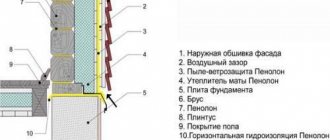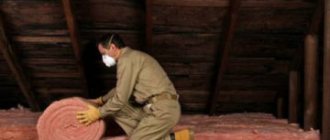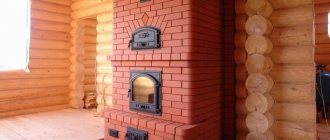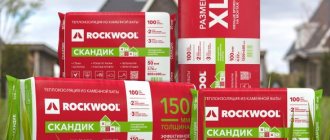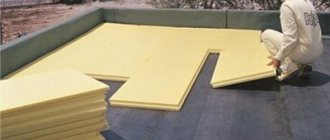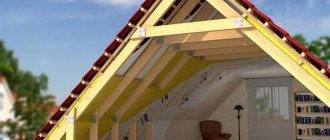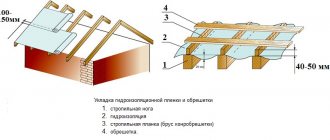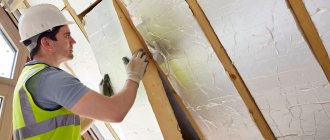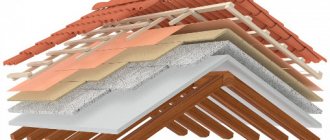Metal roofing is a modern and popular solution, easy to install and affordable. The material has good performance characteristics and can be used on roofs of various configurations. Compliance with installation technology allows you to create a durable roof that provides a high level of protection of the under-roof space and premises from wind, cold and precipitation. The installation of metal tiles should be carried out by qualified specialists to ensure the best results. The process of laying this material has some distinctive features. When arranging such a roof, you need to decide in advance on the type of material and insulation.
Metal tiles are most often used for roofing Source orgtorg.org
What to do with a complex roof shape
Let's tell you frankly: metal tiles are far from the best roofing material for a roof with a complex shape.
Therefore, since there is already one and it needs to be insulated, be sure to think about the ventilation of all its parts. Definitely everyone! The fact is that certain areas without ventilation will be warmer; snow will melt on them and flow down to the eaves, where there is ventilation and the roof covering has a lower temperature (especially on the overhang, under which there is no insulation). And with metal tiles for water, it’s not difficult to find an entrance to the under-roof space.
Further, the melted snow will encounter unmelted snow and remain there, eventually turning into ice. And putting it on is not only a danger for people living in the house when they go outside at the wrong time - it is also a constant destruction of the drain.
This is why the ventilation of a complex roof must be 100%, without missing a single section. To do this, install an intermittent counter-lattice, which allows air flows to move not only in one specific direction, but also in different directions, reaching all zones. Also, a couple of additional aerators will not be superfluous.
And after finishing the insulation, also make sure that the air intake hole in the eaves is always open. It cannot be hemmed with a board, but it can be covered with a slightly bent gutter drip.
As a last resort, we advise you to insulate such a roof from the inside using polyurethane foam, which penetrates into all cracks and hard-to-reach places (and a complex roof always has them), and is not afraid of moisture:
Pros and cons of coverage
The advantages of the material include:
- Light weight.
- High wear resistance.
- Fire resistance.
- Relative ease of installation.
- Good potential for implementing design solutions.
There are also minor disadvantages that can be eliminated with proper planning and execution of work:
- Low sound insulation: during precipitation and strong winds, metal tiles create an increased noise level. The disadvantage is offset by the use of good sound insulation, the function of which is usually performed by a thermal insulation layer.
- Condensation may form in the interior of the roof; to avoid this, care must be taken to provide ventilation and vapor barriers.
How to care for your roof
The polymer coating of the metal tile protects it from rust, but is itself exposed to temperatures, ultraviolet radiation and weather disasters.
Regular cleaning consists of the following simple steps:
- Dried leaves and ordinary dirt are removed with a damp brush with hard bristles;
- Snow is cleared using conventional soft snow clearing devices;
- To wash gutters, use a stream of water under pressure, which is directed from the ridge of the roof towards the eaves;
- Heavy dirt can be removed using gentle polymer surface products;
- Aggressive household chemicals should not be used: they can destroy the protective layer of the roof.
Security arrangement
Snow guards and a transition bridge are important elements that ensure the safe stay of a person on it. A continuous sheathing must be installed underneath them.
They are attached on top of the roofing, but the fixation must be reliable and fully comply with the instructions for standard elements. The fastener must have a rubber gasket.
Snow retainers help prevent large quantities of uncontrolled snow from falling off the roof. The standard elements are a reinforced strip that is attached parallel to the eaves strip.
The snow retainer is attached with self-tapping screws that go right through the metal tiles and enter the sheathing. This way one or several rows of planks can be installed.
Installing additional items
Installing a valley: constructive tips
It is installed at the junction of the slope to the slope, but always together with the overlays. The lower valley strips are laid on the sheathing so that its lower edges are on top of the eaves strips. Then a sealant must be placed on the lower valley slats - it ensures a tight fit of the sheet to the slats. By the way, the valley is attached at the top of the profile wave in increments of 300 mm.
The joint of roofing sheets looks unaesthetic and therefore requires decorative treatment, which consists of laying a strip of the upper valley
End strip
Here it is necessary to use a “bottom-up” scheme, and the overlap of the planks is at least 10 cm in length. The end strip is attached to self-tapping screws in increments of 40 cm.
Something about the eaves strip: proper water drainage
The eaves strip for metal tiles is a longitudinal structural element, the main function of which is considered to protect the frontal board from harmful wetting and from the penetration of moisture into the internal space. The essence of its fastening lies in the following points: the cornice strip is nailed to the front board in a checkerboard pattern (step 300 mm); First, one plank is nailed, then the other is laid overlapping.
Under-roof waterproofing is laid on the last board of the sheathing and the eaves strip
Horse - say no to leakage
Small gaps must be left at the joints of the ridge. The seal is firmly glued to the upper edges of the sheets, the ridge is fixed with self-tapping screws at the apex points through the wave.
A seal with ventilation holes is placed on the ridge, onto which the ridge strip is subsequently attached.
Snow guards - such components should not be neglected
The planks are attached under the second transverse steps of the profile sheets, and a support strip is attached between them at the top of each wave. In addition, the installation of protective snow retainers can be carried out directly to the sheathing: naturally, then it is advisable to use long roofing screws.
Snow guards are installed in places such as the space above the entrance and windows, as well as at each level of the roof if it consists of several levels
In general, all of the above can be summarized unambiguously: installation of metal tiles is a complex process that requires skills, knowledge, and experience. You can’t master it on your own, so it’s better to immediately turn to professional craftsmen, because then the final result will be excellent and pleasing to the eye!
Roofing pie design
The insulated slope in cross-section is a kind of “layer cake”. It is designed quite simply, but serious miscalculations are often made during its construction. The main cause of errors is a lack of understanding of the functions and operating principles of vapor barrier and waterproofing membranes.
Vapor barrier
- the bottom layer of the structure, which in attics is additionally covered with finishing sheathing. The purpose of a vapor barrier is to trap water vapor rising from the house. Without a membrane, the insulation gets wet, and its thermal insulation properties drop up to 25 times.
Strips of rolled material are secured with staplers with an overlap of 10-20 cm. The joints are glued with a special connecting tape.
Waterproofing
- a layer between the insulation and the roof. The material is attached directly to the top of the rafters. Its purpose is to drain water that condenses on the inside of the metal tile and can get on the insulation. For proper operation of the membrane, it is important to install it without sagging so that it does not touch the thermal insulation.
Important! Some future homeowners, wanting to save on lumber, neglect to install counter-lattice. This is only permissible when a “cold” roof is being built. In the case of an insulated structure, failure to pack additional bars (and therefore from the air gap between the waterproofing and metal tiles) leads to the accumulation of condensation on the insulation and its deterioration.
Due to the high profile of metal tiles, snow, raindrops, and debris brought by small birds can be blown under its waves. The most problematic areas are the exit points of antennas and pipes, joints, edges, corners. To minimize the amount of moisture and dirt that gets under the roof, it is necessary to carefully select components for metal tiles. End strips, ridges, valleys, J-chamfers for soffits - there is a wide choice, so you can cover vulnerable spots on a roof of any shape and design.
How to insulate a roof, design tips
Metal tiles are used to cover pitched roof structures.
It is laid on the supporting roof frame - the rafter system. It is recommended to insulate a metal tile roof using a roofing pie made between the rafters. This technology is considered the most effective and gives excellent heat saving results. We can say that in the end, the maximum preservation of heat depends on the filling of the pie. Properly selected and installed, it prevents cooling of the living spaces of the attic and attic, prevents the penetration of moisture from the outside and ensures its removal directly from the pie itself.
The main layers of the roofing pie
It is impossible not to note the roofing material itself – metal tiles. The extent to which the roof and the elements of the “filling” of its roofing pie will be protected from the aggressive effects and physical stress of natural phenomena, snow, rain, and wind largely depends on compliance with the technology of its installation. The safety, absence of wetting and effectiveness of the thermal insulation layer are ensured by a waterproofing film, one or two ventilated gaps (depending on the type of waterproofing material) and vapor barrier material.
Waterproofing a metal tile roof is designed to prevent moisture from entering from the outside. Depending on the purpose of the attic space, it can be either vapor-tight or vapor-permeable.
The waterproofing film is attached to the rafters at the top using staples or galvanized nails. In this case, it is necessary to allow a slight sagging of the canvas up to 1 cm in order to protect it during temperature changes. The sheets are laid across the roof slope with an overlap of the top sheet on the bottom sheet by 10 cm. It is desirable that the waterproofing material have high vapor permeability, otherwise it will be necessary to provide another ventilated layer in the roofing pie.
On top of the waterproofing layer, counter-lattice bars are laid along the rafters, and sheathing bars are laid across. The height of the counter-lattice bars is selected based on the length of the roof slope and the size of the required ventilation gap, and the pitch of the lathing in accordance with the horizontal wavelength of the metal tile, since the roofing material will be attached to it.
For a metal roof, it is especially important to have ventilation for the under-roof space. In its absence, condensation, which forms when the internal and external temperatures differ on the inside of the metal tile, can lead to disastrous consequences for the roof structure
For metal roofs, including those made of metal tiles, it is necessary to use special membranes - anti-condensation membranes.
This material is one-sided, and it should be laid with the rough side facing the insulation.
Thermal insulation layer of a metal roof
It is recommended to make it from breathable materials, usually with a fibrous structure. They are based on basalt or fiberglass. These insulation materials have good thermal insulation characteristics and excellent noise reduction. Another advantage is that they are not flammable. The total thickness of the mineral wool layers under the metal tile roof of an energy-efficient house is at least 20 cm. Fiberglass insulation, due to its structure, has many air gaps, which ensures their low thermal conductivity.
In general, the performance characteristics of mineral wool and fiberglass are similar, although the thermal conductivity of fiberglass is lower.
Penoizol is also used as insulation - liquid foam, a new generation of thermal insulation material.
It is necessary that the thermal insulation mats or slabs be semi-rigid. This way they will hold well in vertical and inclined planes.
Their length should be 2–3 cm greater than the distance between the rafters. The number of layers of insulation to be laid is calculated depending on the thermal conductivity coefficient of the material used for insulation.
Vapor barrier layer of a metal roof
protects the insulation from moisture that comes from inside. It is also attached to the rafters, only from below, using galvanized nails or staples. Similar to laying the waterproofing film, an overlap is performed. To ensure tightness, all “dangerous” junction areas, for example, to walls, pipes, windows, are taped with special tape.
The installation of the roof, insulation and other elements is carried out without deflections, gaps and irregularities with a tight fit to each other, with the exception of ventilation ducts.
2019stylekrov.ru
How to make waterproofing?
When insulating a roof covered with metal tiles, be sure to install a water barrier. This is a special reinforced, vapor-permeable film that protects the attic space from condensation, dust and accidental rain or snow. Pay special attention to the first problem - it is on metal tiles and corrugated sheets as a metal material that condensation quickly accumulates. After all, metal always heats up quickly and cools down just as quickly, creating a significant temperature difference between the object and the air - ideal conditions for the settling of water vapor in the form of droplets.
When steam condensation reaches a critical point - the dew point - water molecules in the air bind and turn into water. The main conditions for this are high indoor humidity and temperature differences. Plus a poorly designed vapor barrier, of course. And thanks to the micro-perforation of modern water vapor barriers, a small ventilation will be created, which will help such droplets evaporate faster. A good budget option.
Polypropylene films with an anti-condensation layer are also suitable for solving this problem. One side of such barriers is made of non-woven geotextile, and the other is waterproofing. The textile insert of such a film adsorbs moisture and steam and removes them through the ventilation gaps. What’s good is that such a film can be left on the roof without a roofing covering for quite a long time, which is why work at heights goes more smoothly.
And finally, new superdiffuse membranes. Their use allows you to create only one air gap between the film and the roofing - and all the condensation will come out on its own. This provides wind protection, protection of insulation, and effective removal of steam from the entire roofing pie. In addition, the membrane itself can be laid directly on the insulation without any additional sheathing - a valuable saving! See what a modern membrane looks like and how different it is from ordinary polyethylene film, even in appearance:
But purchasing a good roof membrane can be a challenge. Even if you contact an official dealer of a manufacturer with a memorable advertisement, it is not a fact that you will end up with a quality product in your hands. Sometimes unscrupulous sellers offer to look at advertising samples of films that have a noticeable rough structure and a certain color and appearance, but in the end they sell a roll of film with slightly different qualities. At the same time, when buyers try to deal with the “forgery,” they refer to the manufacturer’s legal right to change both the color and texture of the products at their discretion. Those. one thing is advertised, another is sold - not often, but this happens periodically in the construction market.
Therefore, when purchasing a superdiffuse membrane, be sure to check it for the following key characteristics:
- Vapor permeability: 0.02-0.03 m.
- Tensile strength: not less than 140 N/5cm.
- Tear-out strength: not less than 50N/200mm.
- Water resistance: degree W1, and the water column is greater than 2000 mm.
- UV stability: 3 months.
Based on these characteristics, membranes are divided into certain groups. Some can be placed directly on the rafters, others can only be in contact with the insulation. And the tensile and tearing strength is the durability of the film itself.
Materials for thermal insulation of pitched roofs
Roof insulation technology involves the use of various materials. The most popular heat insulators include mineral wool and glass wool (in slabs or rolls), slab polymer materials - polyurethane foam, polystyrene foam. The principles of their installation are similar, but it is worth noting that installing slab material is much simpler and more convenient.
As waterproofing, roofing material or a waterproofing membrane is usually used, which is impermeable to water, but capable of removing moisture from the insulation. The vapor barrier layer can be made of
:
- roofing felt;
- polyethylene film;
- glassine;
- foil materials laid with foil towards the attic.
To create a roofing pie with high functional characteristics, it is recommended to use a special vapor barrier membrane to create a vapor barrier: it removes condensation outside from the insulation and does not allow steam and moisture to pass into the roofing pie.
Stage 2. Selecting related products for proper installation of metal tiles
Don't forget about related products for installation work.
- Roofing screws are fasteners equipped with a washer with an EPDM gasket and made of zinc-coated steel.
- Sealing materials are needed to isolate the most vulnerable places from moisture - the joints and junctions of roof elements. They can be produced in the form of tapes or in liquid form.
- Repair enamel aerosol. It will be useful if you need to restore the polymer coating (if it was damaged during installation or transportation of the material).
- Double-sided connecting tape. It is used to hermetically seal the joints of steam and waterproofing sheets. Otherwise, the vapor and waterproofing will not be able to perform its functions - it will allow moisture to pass through.
Calculation of the amount of metal tiles
To calculate the required number of sheets of material, you first need to decide on the type of profile and the manufacturer of the metal tile - you will need the exact dimensions of the material itself, and each profile has its own. Then you need to make accurate measurements of the slopes - length, height, if any, you need to measure all the protrusions or other decorative elements that will need to be sheathed with roofing material. If the roof has a complex shape, it is better to draw a plan, put down all the dimensions and then start doing the calculations.
Number of rows
It is best to look for metal tiles not in stores or markets. It is advisable to contact the manufacturer directly. The point is not only the price - it may not differ very much, but the fact that many workshops/factories offer to cut sheets of the required sizes. The minimum sheet height is 0.7 m, the maximum is 8 m. That is, you can order the required number of sheets covering the roof slope from the ridge to the overhang (taking into account the eaves overhang).
This option is good because a metal tile roof will not have horizontal joints, which means there will be less chance of leaks. The second plus is a minimal amount of waste and a smaller amount of material itself (due to the absence of horizontal overlaps, several square meters are saved). Disadvantages: difficulties with delivery, lifting long sheets to the top, inconvenient installation.
Calculation of a rectangular roof slope
When using sheets of standard sizes, the height of the roof slope is divided by the useful length of the sheet. The resulting figure is always rounded up. The useful length is obtained after subtracting the amount of horizontal overlap from the total length - from 100 to 200 mm. The flatter the slope, the greater the overlap of the sheets is necessary so that precipitation cannot get into the under-roof space. On roofs with a slope of up to 12°, one sheet overlaps the other by at least 200 mm; with a slope of 12° to 30°, the overlap is 150-200 mm, more than 30° - 100-150 mm. The specified amount of overlap is subtracted from the total length of the sheet, this will be the “useful length”.
An example of calculating the number of rows of metal tiles on a roof. Let the length of the slope be 4.5 m, the useful length of the sheet is 2.3 m. Divide 4.5 by 2.3, we get 1.95, round to the nearest whole number - we get 2 rows. In this case, only a small part of one sheet will go to waste, but there are times when more than half is cut off. This is very unprofitable, since this piece cannot be used anywhere else.
Number of sheets in a row
Take the length of the slope and divide it by the usable width of the sheet. This parameter is indicated in the technical specifications for metal tiles. Most often it is 110 cm (1.1 m). We round the resulting number up to obtain the number of sheets in the row.
An example of calculating metal tile sheets in a row. Let the length of the overhang be 8 m, the useful width of the sheet 1.1 m. When dividing, we get 7.27 pieces, but round up to a larger integer and we get 8 pieces in one row. Moreover, more than 2/3 of one sheet will go to waste.
Features of hip roofs
Hip roofs have slopes that are triangular or trapezoidal. Here it is necessary to select the length of the sheet in order to minimize the amount of waste.
An example of the layout of metal tile sheets on a hip roof
The height is selected so that no more than half goes to waste. It is quite difficult to do this manually, and there is still a significant error - there will be 20-25% more waste than when calculated using programs. They are usually available from sellers and manufacturers. It is better to provide them with an accurate calculation, and first measure the parameters of the roof at home (or call a measurer), and then try to select the dimensions yourself. Then you can compare the amount of material needed, calculated by you and proposed.
Determining the number of additional elements
A metal tile roof requires a large number of different additional elements (additions), which form the ridge, the edge of the overhang, the sides of the slope, the passage of the pipe, the valley (the junction of two adjacent roof slopes). The more complex the shape of the roof, the greater the amount of additions required. With a simple gable roof, ridge elements and caps, cornice and pediment strips will be needed. That's all.
What types of additional elements are there for metal roofing and why are they needed?
Despite the wide variety of extras, they are all considered the same. Take the length of the surface on which it needs to be mounted and divide by the useful length of the element. It is usually standard and is 1.9 m (total length 2 m). The result obtained is rounded up.
Rafter system, hydro- and thermal insulation, lathing and angle of inclination
Installation of a metal roof begins with the installation of a rafter system.
The process is carried out using the following technology :
- to anchor bolts or studs;
- The rafters are installed on the support beam, fixed with corners, from above they are cut at an angle and connected in pairs by cross members and steel strips.
If the roof is high or has a large area, then a ridge beam is installed, the rafters are attached above it and everything is pulled together with corners.
A high roof requires additional installation of ridge beams Source krsk.au.ru
Almost always, the roof is insulated with special materials, which increases its performance characteristics and functionality. The support for the insulation is the sheathing, and the top is covered with waterproofing. For the lathing, wide boards are used, the distance between the first lower strips is up to 15 cm. Fastening to the rafters using two nails to create the most reliable base for metal tiles.
The roof arrangement scheme is quite complex Source pinterest.com
The installation of metal roofing is carried out with acceptable standards for the angle of inclination. At the same time, the angle of inclination determines other indicators of the roof, such as the type of metal tile, frame design, and the weight of the roofing pie. The greater the slope, the more materials will be required due to the increased area of the slope, while the windage of the structure increases. The optimal angle is 22 degrees, the minimum is 14 degrees; if you make it smaller, then it is impossible to use the attic space and the necessary strength of the entire structure is not ensured.
Design of security elements and their purpose
Ladder
To climb to the roof, you need a stable ladder. It consists of wall and roof ladders with brackets. 4 brackets are required per section; they are placed in the place of the lower wave bend, where the sheathing is solid. Both the brackets and the top of the roof ladder are secured with bolt screws. The wall staircase is installed so that the topmost step is opposite the edge of the cornice. In this case, the wall staircase itself must be aligned with the roof staircase.
Roof fencing
These metal elements are a necessary condition when working on the roof. They are secured using special supports to the continuous sheathing through the lower part of the wave, sealing with a rubber gasket. See photo above.
Transition bridge
Walking bridges are needed for safe walking on the roof from an attic window, hatch or staircase. They are fastened in the same way as fences, only continuous sheathing is not necessary.
Snow guards
Snow guards have a tubular design and are made of metal painted black, brown, red or green. They are installed along the entire perimeter of the roof, above the eaves overhang. In addition, they must be placed above the entrance to the house, attic windows, as well as above each level of a multi-tiered roof.
>Metal Profile roofing system diagram
Below is a diagram of the roofing system of the Metal Profile company. On it, all the nodes discussed above are connected into a whole roof.
What and how to attach it to
The metal tiles are secured with special self-tapping screws and rubber washers. Just like the main material, they are made of galvanized steel, and the top is painted to match its coating. When installing, the self-tapping screw must be screwed in strictly perpendicular to the roof surface; tilting it is not allowed.
How to properly screw self-tapping screws into metal tiles
When fastening metal tiles, you need to monitor how tightly the fasteners adhere to the surface. You cannot tighten it too much, bending the metal, but you also cannot allow a loose fit - the connection will not be airtight.
Insulation of a flat roof
What should you use?
- Load-bearing base.
- Vapor barrier.
- Roll material (roofing felt).
- Insulation.
The bulk layer on a flat roof consists of a cement-sand mixture and a drainage layer.
The order of layers in the “roofing pie” depends on the type of roof. In the traditional type, the insulation is protected by a waterproofing carpet, and in the inversion type, the opposite is true.
How to insulate a roof
Insulation of flat roofs.
To begin with, the roof should be thoroughly cleaned of excess moisture, foreign objects and dirt. This point should be given special attention; excess moisture will saturate the space in the under-roof layer with moist steam and penetrate into the open pores of the insulation
As a result, this can even lead to swelling of the roof covering and the formation of air pockets, which can significantly affect the insulation. Next, a waterproofing coating should be applied to the insulation; it is important to do this immediately, avoiding any contact of water on a flat surface. To distribute the load evenly, during installation, workers must move strictly along the inventory walkways. It is important to lay the thermal insulation towards yourself, starting from the edge opposite to the roof exit.
These simple rules require very careful study, but your efforts will not be in vain, and in return you will receive high-quality thermal insulation.
Often, when installing roofing materials, big problems arise, and as a result, you have to change the rafter system, which has worn out and completely deteriorated due to insulation that was previously done incorrectly
Therefore, roof insulation must be approached with great care. On the roof of a private wooden house, the rafters may become damaged, the sheathing may become unusable, and all this in literally just 5 years
Therefore, it must be installed correctly and on time, as soon as the team completes the rafter system. and the insulation can be installed after the roof is installed.
Share a useful article:
Why is it important to take a responsible approach to insulation?
In summer, the sun heats up the thin sheet steel from which roofing material is made. If builders are not conscientious about insulation, a considerable part of the generated heat enters the attic or attic, turning the room into a bathhouse. In winter, on the contrary, the homeowner is forced to literally “heat the heavens” in order to achieve a comfortable microclimate in the house.
Thin metal, if not insulated enough, also creates a “drum effect”. It is expressed in loud annoying noise during rain and hail. If the metal tile is installed incorrectly, it also makes a lot of noise when subjected to temperature deformations. Therefore, if you are going to build your first roof, it is better to choose corrugated sheeting as a roofing cladding. The principles of its installation are simpler, the material is easier to handle.
Gross mistakes when laying thermal insulation reduce the service life of the entire roof. Moisture from wet insulation causes rotting of the wooden rafter system.
Stages of work on insulating a pitched roof
The roof insulation scheme is quite simple. First of all, you need to measure the distance between the rafters. The slabs of cotton wool insulation should be cut according to the results obtained, adding 1 centimeter. This will allow you to fasten the heat insulator between the rafters. This stage of work is greatly simplified if the roofing system is initially designed and installed based on the use of slab insulation boards of a certain width.
If there is no waterproofing between the rafters and the already installed roofing, you should first secure a water barrier. The membrane should envelop the rafters; it is most convenient to fasten it with a construction stapler to the rafters themselves and to the roof sheathing in the openings between them. The waterproofing must be installed under the eaves at the bottom of the roof to ensure moisture drainage. It should be taken into account that with this method of fastening the hydrobarrier, the insulation must be installed without the necessary air gap. For this reason, it is recommended to use a superdiffusion membrane as a waterproofing material.
If there is a waterproofing layer under the roofing, nails are placed on the rafters in increments of about 10 cm. The nails should be located at a distance of 3-5 cm from the waterproofing layer. It is necessary to stretch a polyethylene thread or cord between the nails, tamping them to the end. This will help create an air gap between the hydrobarrier and the insulation. If the heat insulator is planned to be fixed with a cord, and not with lathing for internal cladding, nails must also be driven along the outer edge of the rafters.
If, when deciding how to insulate the roof of a house, you chose cotton slab insulation, then the prepared elements must be slightly compressed and inserted between the rafters
When using stiffer foam boards and similar materials, it is important to accurately size them so that the boards fit snugly into the opening. It is recommended to carry out insulation in two layers
If you have to mount not solid sheets into the opening, but narrower fragments, joining them along the length or width, you need to make sure that the joints of the second layer do not coincide with the joints of the first. The heat insulator should not protrude beyond the plane of the rafter legs. If the rafters are not wide enough to install two layers of insulation, additional timber is nailed to them.
The heat insulator is fixed between the rafters using a stretched cord secured to pre-filled nails. Or, as a fastening, a lathing made of slats is used, intended for mounting the interior lining of the room. The slats are nailed to the rafters in increments of 30-40 cm. In this case, the vapor barrier is stapled to the rafters before installing the sheathing: the thickness of the slats allows you to create the necessary air gap between the vapor barrier and the sheathing.
When installing a vapor barrier, special attention is paid to the tightness of the layer. The panel is laid with an overlap of at least 10 cm, the joints should be taped with adhesive tape in two layers
It is necessary to install the vapor barrier around the chimney and at the junction with the walls as efficiently as possible. At the final stage, the sheathing is installed using wood-based or plasterboard boards.
You can learn more about how to insulate the roof of a house from the video.
Laying technology
The laying of metal tiles is carried out after the assembly of the rafter frame and sheathing is completed. To avoid getting the wooden frame elements wet, installation should be carried out in dry weather. For safety reasons, it is prohibited to carry out work at height in windy weather. To lay the metal profile with high quality. There is the following instruction:
- Waterproofing material is laid on top of the rafters, starting from the roof overhang. Laying is done with a slight sag so that the waterproofing does not burst under water pressure. The film is attached to the rafters with a stapler; an overlap between the strips is made of 10-15 cm, gluing it with adhesive tape.
- Counter-lattice slats are installed along the rafters directly on top of the waterproofing, which form a ventilation gap necessary to protect the roofing material from condensation.
- Then, perpendicular to the rafter legs of the frame, the lathing is fixed to the counter-lattice with a step equal to the wavelength of the metal profile.
- Metal tile sheets are cut to fit the dimensions of the slope. If you buy the material directly from the manufacturer, then the cutting is done at the factory, so there will be no horizontal joints between the sheets. You can cut metal profiles outside of production with a circular saw, jigsaw or hacksaw.
- Begin laying from the lower right edge of the slope. If laying is done in one row, then the sheets are attached one after another. If the installation is carried out in 2 rows, then first lay the outermost sheet at the bottom of the slope, then fix the sheet above it, then the 2nd sheet of the first row, and so on.
- The sheet is attached to the sheathing using roofing screws with a rubber press washer, which closes the fastening hole from water penetration. The screws are screwed in strictly at right angles to the surface of the roofing material, leaving a gap of 1-2 mm so as not to deform it. To fix 1 sheet, 10-15 screws are required.
- During installation, metal tiles overlap each other by 1 wave. The place where the sheets overlap is fixed with self-tapping screws through a capillary groove.
Note! When fixing metal tiles, it is important not to twist the self-tapping screw to avoid deformation of the material and chips on the polymer coating. To do this, it is better to use a screwdriver at low speeds.
Material laying technology
Sheet fastening scheme
Location of attachment points
Video description
In the video you can see the rules for installing a roofing pie:
Roof covering
High-quality metal tiles have a thickness of 0.4-0.6 mm and several layers of protection. It is almost impossible to visually check the presence of internal protective layers, so when purchasing roofing material, ask the seller for a certificate. To protect against corrosion, metal tiles are painted on the inside, and on the outside they have a polymer coating, which resists external influences much better than paints and varnishes. The durability and cost of the roof depend on the type of external protective layer. The most common types of polymer coatings are:
- Polyester . The thickness of the protective layer is 25-30 microns. It has an affordable price and relatively high performance characteristics. The warranty period for metal tiles with polyester coating is 8-10 years;
Metal tiles with polyester coating Source satu.kz
- Polyurethane . It is characterized by resistance to mechanical damage, temperature changes and various chemicals. When the sheet is bent, such a coating does not lose its integrity;
- Polyvinyl chloride . Demonstrates high resistance to mechanical, chemical and thermal influences. Has high plasticity. Metal tiles with this coating are recommended for installation on textured surfaces. It is advisable to use in regions with extremely hot climates;
- Plastisol . Consists of polyvinyl chloride with the addition of a plasticizer. It is applied in a layer of up to 200 microns, which allows you to apply a relief pattern to the surface of the metal tile. They have low resistance to high temperatures, which does not allow its use in regions with hot climates.
Metal tiles coated with plastisol - Solano model Source takinado.com.ua
Interior decoration
A ventilation gap is also formed between the vapor barrier membrane and the sheets of plasterboard or OSB. For this, wooden slats with a cross section of 20x30 mm are used, attached to the rafters perpendicularly.
Expanded polystyrene
This material plays a fairly significant role in any construction. Not every insulation has such excellent characteristics and such an affordable price. When carrying out thermal insulation measures with your own hands, you can significantly reduce the monetary costs of operating a building, and selecting high-quality insulation will help save electricity, which is expensive in these days, and roof insulation will help with this. Metal tiles are a material that will be quite profitable in economic terms due to the price-quality ratio.
Necessary tool for construction
When doing the work yourself, you should prepare the following tool in advance:
- Bulgarian,
- electric drill,
- screwdriver,
- metal scissors and film cutting scissors,
- hacksaw,
- metal hacksaw,
- hammer,
- chisel,
- file,
- axe,
- construction knife,
- roulette,
- metal ruler,
- square,
- plumb line,
- building level,
- marker,
- construction or furniture stapler,
- paint brushes and roller.
An important element of the roof sheathing
To create the sheathing, use bars with a cross-section of 50/50 mm and edged boards measuring 32/100 and 50/100 mm. At the bottom of the roof slope, along the eaves overhang, two 50/100 boards are nailed. Then a counter-lattice made of 50/50 mm bars is placed on top of the waterproofing. The bars are nailed along the rafters, from the ridge to the bottom. On top of this counter-lattice, with a certain step, sheathing boards are attached horizontally. The fastening step of these boards will depend on the type of metal tile profile that is planned to cover the roof.
Ridge sheathing
The uppermost part of the roof requires strengthening. To do this, you need to nail a pair of boards on each side of the ridge strip.
From the end of the roof you need to nail boards larger than the main sheathing to the height of the metal tile profile.
The valley is the internal junction of two roof slopes. Where the valley passes, the sheathing is made continuous.
Roof fencing
It simply must be reliable, so it is made above the overhang of the eaves. As a guide, you can take the height of the load-bearing wall. The sheathing in these places needs continuous sheathing. Therefore, additional boards are added between the ordinary sheathing and a continuous base is made.
The final elements of the roofing system
End strips
End strips are installed at the end of the roof. They are secured with self-tapping screws every 50 - 60 cm. In this case, the overlap between adjacent planks should be about 50 mm.
Ridge strips
These elements come in flat or rounded shapes. The latter additionally require a plug to be attached to its end. It can be simple and conical, fastened with rivets or self-tapping screws. Before installing the planks, place a seal (universal or shaped) under the ridge. The planks are mounted using ridge screws.
Types of waterproofing substrates
In a high-quality roof, it is necessary to provide for the formation of condensation not only directly under the metal tiles, but also from the insulation side.
To do this, first of all, an anti-condensation layer is applied to the inside of the film and a gap is left for ventilation. The formation of condensation depends on whether the roof is warm or cold. Its intensity and volume are directly related to the temperature above and below the substrate.
There are three types of films in total:
Classic film
It is important to maintain ventilation in two circuits:
- Between roofing material and waterproofing
- Between waterproofing and insulation
Fastening metal tiles to the structure
Sheets of metal profiles are attached to the sheathing. For this, roofing screws , which are screwed into the cavity of the tile wave using an electric drill.
As a rule, fasteners start from the ridge side. During work, you should move along the profile with great care, as the material is easily pressed through.
After completing the fastening of the tiles, you can begin installing additional elements.
These are the main stages of installing metal tile roofs.
Working with this material is relatively simple; the main difficulties are associated with ensuring good ventilation and protecting the roof from moisture and wind.
Selection of thermal insulation material
To thermally insulate a roof with a cover made of metal tiles, it is better to use thermal insulators with a fibrous structure. The most common of them:
- glass wool;
- mineral wool.
Minvata
Mineral wool and similar materials with a fibrous structure have remarkable thermal insulation properties. They very effectively remove excess moisture from under the roof space into the external environment. A specific membrane fabric film will prevent condensation from remaining inside the building.
When performing roof insulation work on the inside of the attic space, the mineral wool must be cut in advance into fragments having the required dimensions with an allowance of 2 or 3 centimeters. Before installing the insulating material in the gaps between the rafters, it needs to be compressed a little. Upon completion of installation work, the insulation will expand again and completely occupy the space intended for it.
Styrofoam
As a material characterized by ease of self-installation and affordable cost, you can use the well-known polystyrene foam. It weighs little, is produced in the form of slabs and does not create additional load on the roof structure.
Polystyrene foam also has its drawbacks:
- low vapor conductivity, which threatens the accumulation of condensate under the roof and dampness in the house;
- the material attracts rodents who like to build their nests in it, which will significantly damage the insulation of the attic..
Polyurethane foam
This material can be applied in foamed form to any surface being processed, regardless of its shape and design complexity. The process takes place using a specific portable installation with a sprayer, from which the substance is supplied under significant pressure. In this way, it is possible to insulate the plane, regardless of its angle of inclination.
In addition, the use of polyurethane foam eliminates the need to lay a vapor barrier layer, which would protect the elements of decorative finishing of the living space from condensation penetration. The cost of such material is less economical than that of other materials used for heat insulation.
Ecowool
This building material is manufactured in a compressed form and will need to be loosened before being used for its intended purpose. Often, in order to return the material to its original shape, make it more voluminous and apply it to the insulated surface, special blowing equipment is used.
The technology for laying polyurethane foam and ecowool is not too complicated; the work can be done without the use of a structure for support. The use of insulation materials in rolls or panels will require more strict adherence to the rules of installation technology.
This is interesting: Types of alarm systems for dachas - we explain in detail
Insulation materials
Comfortable living in a house depends entirely on the quality of the materials used in its construction. When choosing these, special attention should be paid to the materials for the roof.
Whatever the top covering, be it metal tiles, bitumen shingles or ceramic, it is also important to take care of the thermal insulation of the roof. To do this, you need to competently approach the problem of choosing insulation for the roof. Modern foreign and domestic manufacturers offer a fairly wide range of these products. Comfortable living in the house, whether it will be cozy and warm enough during the cold season, largely depends on the correct choice of the type of material for roof insulation.
Choosing the right insulation for the roof
So, how to choose the right insulation for your roof? What should you pay attention to first? First of all, the type of insulation under the roof should be selected depending on the type of roof.
Today, the following main types of roofs are distinguished:
- single slope;
- gable;
- tent;
- flat;
- hip (gable, hipped)
This, of course, is far from a complete classification. The type of roof is determined by the geometric shape and roofing material. The most common and practical design is rightfully considered a gable roof. Moisture does not linger on it, but flows freely down inclined planes.
What should you pay attention to when choosing a material for roof insulation?
When deciding which insulation is best for the roof of a private house, garage, bathhouse, etc., you should first understand the selection criteria. These include:
- Material service life. It must be long lasting. In this case, the material should not lose its properties during operation.
- Form stability. The reliability of a particular material for roof insulation depends on its ability to maintain hermetic parameters.
- Specific gravity. The material should not be too light or heavy, therefore, you need to pay attention to the density indicator.
- Frost resistance. The insulation should not lose its properties when the air temperature changes.
- Soundproofing. It is necessary to pay attention to the soundproofing properties of the material, especially when it comes to purchasing insulation for a pitched roof made of “noisy” material.
- Environmental friendliness. The material must be environmentally friendly and non-toxic.
An equally important role is played by the thickness of the roof insulation. When calculating this parameter, it is necessary to take into account the thermal resistance of the structure and the thermal conductivity of the material; the resulting coefficient depends on the type of roof and the climatic characteristics of the region.
It is quite possible to cope with roof insulation work on your own, without the involvement of specialists, the main thing is to avoid some mistakes.
First of all, what should be the best roof insulation? Lightweight, non-flammable, safe and of high quality, suitable for the type of roof structure.
The most common mistakes when insulating a roof
- Saving on quality. In this case, the rule applies: “the miser pays twice.” Don't try to save as much as possible. It is best to purchase materials from well-known manufacturers that have proven themselves positively. The construction market offers a fairly wide range of roof insulation materials, the prices of which are quite reasonable.
- There must be enough material, otherwise the layer will be too thin: it simply will not perform its functions.
- The material must be chosen carefully, especially when it comes to insulation for a flat roof. It is best to use mineral basalt wool of increased rigidity or foam concrete for these purposes. In this case, it is also important to be guided by the design documentation, the design features of the roof and its operating conditions (attic, attic). If the roof surface is subsequently used, it is necessary to lay a concrete screed on top of the insulation.
- Particular attention should be paid to hydro- and vapor barrier. The number of joints and seams of the insulation determines how well the material will prevent the outflow of heat and the penetration of cold.
- The gaps between the layers of the roofing “pie” should not be neglected, especially when it comes to insulation for a soft roof. During the installation process, it is necessary to take into account the circulation of air flows between the layers.
- When laying the insulating layer between the rafters, it is important to carefully measure the insulation to avoid the formation of cracks.
Materials for roof insulation
Today, the most common and popular materials for roof insulation are the following:
- mineral wool (Knauf, Ursa, Izover insulation);
- expanded polystyrene;
- polyurethane foam;
- cellulose insulation;
- foam concrete;
- foam glass;
- expanded clay
Each of these materials has its positive and negative aspects.
Mineral wool
Mineral wool is an ideal material for high-quality roof insulation - it does not burn and does not absorb moisture at all. Since the properties of the material have long been recognized and it is considered the best for roof insulation, it is represented on the market by several reputable manufacturers.
Roof insulation Knauf
The material is produced in rolls and slabs and is intended for insulation of walls and all types of roofing. Knauf insulation occupies a leading position in its segment in the construction markets of Europe and the CIS countries. This universal thermal insulation material is made on a fiberglass basis using ECOSE Technology and meets all generally accepted European quality standards. This is an environmentally friendly insulation material with high thermal insulation properties and low specific gravity.
Rules for working with heat insulators
When working with a heat insulator, you must follow a number of rules so that it fulfills its functions and the insulated roof serves you for many years.
Storage and installation
Firstly, moisture should not get on the surface of the materials either during storage or during installation, so the insulation must be stored in a room well protected from moisture.
Preventing the ingress of moisture during installation is carried out by installing a waterproofing layer
It reliably protects the material from getting wet, preventing it from becoming saturated with water - this is a particularly important condition for the normal use of mineral wool.
Instructions
Before you start using, carefully read the instructions for the insulator. Many people believe that all insulation materials of the same type are the same, but this opinion is wrong. Only the goals of such materials are common, but the installation process, storage conditions and other important points are often different.
Handy tools
Never neglect the reliability of the tools at hand. No matter how high-quality the materials for insulating a metal roof are, if you cut them with a dull knife, nothing good will come of it, you will only ruin the insulator.
Safety regulations
Remember about basic safety rules that apply not only to the thermal insulation of roof structures, but also to any other construction activities.
We are talking about wearing safety glasses, durable gloves, a respirator, etc. Even a small metal chip that accidentally gets into the eye can cause serious injury.
Let's sum it up
How high-quality and functional the insulated structure will be will depend entirely on how correctly and conscientiously the thermal insulation work is carried out. Saving on roof insulation is not the most reasonable option. A well-insulated roof will significantly reduce the cost of heating your home. If you choose metal tiles, it is recommended to insulate using fibrous heat insulators (glass and mineral wool). Such materials are distinguished by their reliability, long service life and excellent sound insulation qualities. It is also worth remembering that these materials are not subject to combustion, which is also important in private construction.
